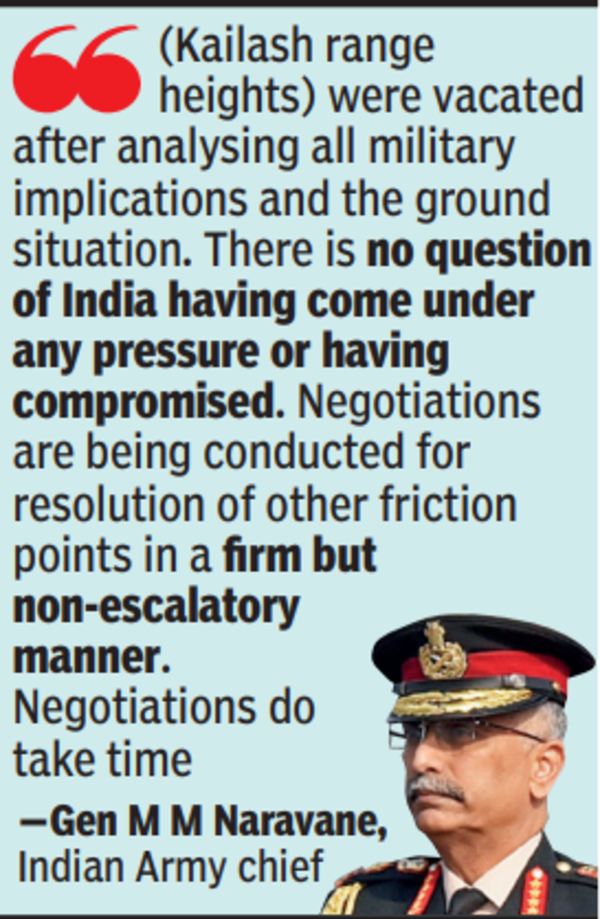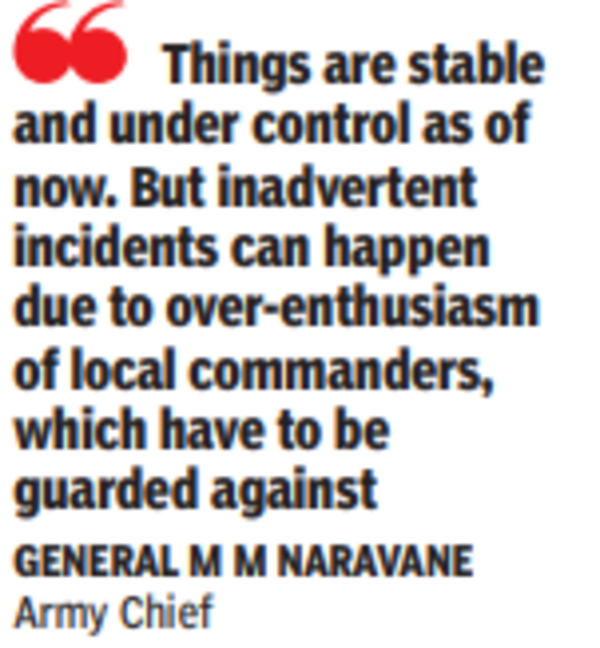- News
- India News
- Army ready to thwart any mischief by China, while talks underway to resolve remaining 'friction points': General M M Naravane
Trending
This story is from May 29, 2021
Army ready to thwart any mischief by China, while talks underway to resolve remaining 'friction points': General M M Naravane
The Army is maintaining high operational readiness to `thwart’ any `unusual activity’ by China all along the northern borders, said General M M Naravane on Friday, while rejecting concerns that India squandered its leverage by vacating the Kailash Range heights without extracting any concession on Depsang Plains in eastern Ladakh.

The Army chief General M M Naravane, in an exclusive interview to TOI, asserted the Rezang La-Rechin La heights in the Kailash Range were vacated as part of the troop disengagement plan on both sides of Pangong Tso in February after “analyzing all military implications and the ground situation”.
NEW DELHI: The Army is maintaining high operational readiness to `thwart’ any `unusual activity’ by China all along the northern borders, said General M M Naravane on Friday, while rejecting concerns that India squandered its leverage by vacating the Kailash Range heights without extracting any concession on Depsang Plains in eastern Ladakh.
The Army chief, in an exclusive interview to TOI, asserted the Rezang La-Rechin La heights in the Kailash Range were vacated as part of the troop disengagement plan on both sides of Pangong Tso in February after “analyzing all military implications and the ground situation”.
“There is no question of India having come under any pressure or having compromised,” said Gen Naravane. Diplomatic and military negotiations are in progress for resolution of the remaining face-off sites like Hot Springs, Gogra and the strategically-located Depsang Plains.

But with the People’s Liberation Army (PLA) digging in its heels to even complete the stalled disengagement at patrolling points (PPs) 15, 17 and 17A in the Hot Springs-Gogra-Kongka La area, Gen Naravane acknowledged troop de-induction and the consequent de-escalation along the frontier would take some time.
The PLA also continues to block Indian patrols from going to their traditional PPs-10, 11, 11A, 12, and 13 in Depsang, which are well short of India’s perception of the Line of Actual Control in the region.
“Depsang Bulge is a legacy issue where the differing perception and obstruction to patrolling has been there for some time. The issue needs to be amicably resolved at the earliest,” said Gen Naravane.
The Army is maintaining a force-level of around 50,000-60,000 soldiers in forward areas to take care of all contingencies. “Our forces are ready to thwart any unusual activity on part of our neighbour. Things are stable as of now, but we cannot be complacent. We have to keep a strict watch. We are doing it,” he said.
Excerpts from the interview:
Q: What is the current ground situation in eastern Ladakh?
A: Partial disengagement has been undertaken in the areas on the north and south banks of Pangong Tso and the Kailash Range. In these areas, the troops from either side, as per agreement, have been pulled back to their respective permanent locations in February. There has been no infringement of the pact from either side till now.

The troop disengagement from the rest of the stand-off points is being deliberated by the military commanders on both sides, augmented by the diplomatic machinery.
Notwithstanding the disengagement, China continues to deploy its mechanized elements (tanks and armoured vehicles) and troops in immediate depth areas. Overall, the force-levels remain the same…around 50,000-60,000 each. There has been some disengagement, but de-induction of troops and de-escalation has not happened.
We are aware the PLA is also carrying out summer exercises in their traditional training areas opposite eastern Ladakh, with additional formations having come in there. We are keeping an eye out for any activity that may be interpreted as out of the ordinary. Our forces are ready to thwart any unusual activity on part of our neighbour.
Q: Can the situation escalate again?
A: Things are stable and under control as of now. But inadvertent incidents can happen due to over-enthusiasm of local commanders, which have to be guarded against. We, of course, cannot be complacent. We have to keep a strict watch. We are doing it. Negotiations are being conducted for resolution of other friction points in a firm but non-escalatory manner.
Q: But the 11thround of corps commander-level talks on April 9 failed to achieve any breakthrough? PLA refused to complete the stalled disengagement at Gogra, Hot Springs and Demchok as well as stop blocking Indian patrols in Depsang?
A: We should not expect a result from every round. The disengagement at Pangong Tso happened after 10 rounds. The next round will take place.
Q: The Doklam confrontation in 2017 lasted for 73 days…
A: The Sumdorong Chu face-off (in the 1980s) lasted for some years. It’s difficult to give a timeframe. Issues remain to be resolved at the friction points. Negotiations do take time. We will resolve them by-and-by.
Q: There are major concerns that India should not have vacated the Chushul-Kailash Range heights without extracting concessions from China on Depsang Plains, where access of Indian patrols to hundreds of sq km of territory has been cut off?
A: Vacation of Kailash Range as part of the Pangong Tso disengagement plan was undertaken after analyzing all military implications and the ground situation. There is no question of Indian side having come under any pressure or having compromised.
Depsang Bulge is a legacy issue where the differing perception and obstruction to patrolling has been there for some time. The issue needs to be amicably resolved at the earliest.
Q: You recently said the threat from China has `only abated’ but `not gone away altogether’. The PLA continues with force levels as before. Will de-escalation take place or will the LAC turn into another LoC (with Pakistan) with permanent deployments?
A: It is true the Chinese troops who had mobilized from depth areas continue to be deployed in intermediate depth areas opposite the LAC in eastern Ladakh. Hence, the threat continues to exist.
Talks during the 10th round of meeting between the senior military commanders led to a disengagement (at Pangong Tso), which has been monitored and verified by both sides.
However, the discussions over the remaining areas need to be expedited to reflect the status quo ante of April 2020. Success in these discussions will create a positive and trustful environment for both countries to resolve their remaining issues peacefully. Our stance is very clear: both sides should restore “status quo ante” as prevailing on or before April 2020 and avoid reoccurrence of such incidents.
Q: What about other stretches of the LAC like Arunachal Pradesh and Sikkim? China is also building villages and settling civilians in border areas?
A: In other stretches, the situation remains peaceful with normal deployments of the PLA. As for the villages, China is building them but they have not encroached on Indian territory. It’s part of some grand design, which is difficult to deduce…possibly to populate their areas which were earlier not occupied.
The Army chief, in an exclusive interview to TOI, asserted the Rezang La-Rechin La heights in the Kailash Range were vacated as part of the troop disengagement plan on both sides of Pangong Tso in February after “analyzing all military implications and the ground situation”.
“There is no question of India having come under any pressure or having compromised,” said Gen Naravane. Diplomatic and military negotiations are in progress for resolution of the remaining face-off sites like Hot Springs, Gogra and the strategically-located Depsang Plains.

“Negotiations are being conducted for resolution of other friction points in a firm but non-escalatory manner. Negotiations do take time. We will resolve them by and by,” he said. India has made its position very clear to China that “both sides should restore the status quo ante as prevailing on or before April 2020”, he added.
But with the People’s Liberation Army (PLA) digging in its heels to even complete the stalled disengagement at patrolling points (PPs) 15, 17 and 17A in the Hot Springs-Gogra-Kongka La area, Gen Naravane acknowledged troop de-induction and the consequent de-escalation along the frontier would take some time.
The PLA also continues to block Indian patrols from going to their traditional PPs-10, 11, 11A, 12, and 13 in Depsang, which are well short of India’s perception of the Line of Actual Control in the region.
“Depsang Bulge is a legacy issue where the differing perception and obstruction to patrolling has been there for some time. The issue needs to be amicably resolved at the earliest,” said Gen Naravane.
The Army is maintaining a force-level of around 50,000-60,000 soldiers in forward areas to take care of all contingencies. “Our forces are ready to thwart any unusual activity on part of our neighbour. Things are stable as of now, but we cannot be complacent. We have to keep a strict watch. We are doing it,” he said.
Excerpts from the interview:
Q: What is the current ground situation in eastern Ladakh?
A: Partial disengagement has been undertaken in the areas on the north and south banks of Pangong Tso and the Kailash Range. In these areas, the troops from either side, as per agreement, have been pulled back to their respective permanent locations in February. There has been no infringement of the pact from either side till now.

The troop disengagement from the rest of the stand-off points is being deliberated by the military commanders on both sides, augmented by the diplomatic machinery.
Notwithstanding the disengagement, China continues to deploy its mechanized elements (tanks and armoured vehicles) and troops in immediate depth areas. Overall, the force-levels remain the same…around 50,000-60,000 each. There has been some disengagement, but de-induction of troops and de-escalation has not happened.
We are aware the PLA is also carrying out summer exercises in their traditional training areas opposite eastern Ladakh, with additional formations having come in there. We are keeping an eye out for any activity that may be interpreted as out of the ordinary. Our forces are ready to thwart any unusual activity on part of our neighbour.
Q: Can the situation escalate again?
A: Things are stable and under control as of now. But inadvertent incidents can happen due to over-enthusiasm of local commanders, which have to be guarded against. We, of course, cannot be complacent. We have to keep a strict watch. We are doing it. Negotiations are being conducted for resolution of other friction points in a firm but non-escalatory manner.
Q: But the 11thround of corps commander-level talks on April 9 failed to achieve any breakthrough? PLA refused to complete the stalled disengagement at Gogra, Hot Springs and Demchok as well as stop blocking Indian patrols in Depsang?
A: We should not expect a result from every round. The disengagement at Pangong Tso happened after 10 rounds. The next round will take place.
Q: The Doklam confrontation in 2017 lasted for 73 days…
A: The Sumdorong Chu face-off (in the 1980s) lasted for some years. It’s difficult to give a timeframe. Issues remain to be resolved at the friction points. Negotiations do take time. We will resolve them by-and-by.
Q: There are major concerns that India should not have vacated the Chushul-Kailash Range heights without extracting concessions from China on Depsang Plains, where access of Indian patrols to hundreds of sq km of territory has been cut off?
A: Vacation of Kailash Range as part of the Pangong Tso disengagement plan was undertaken after analyzing all military implications and the ground situation. There is no question of Indian side having come under any pressure or having compromised.
Depsang Bulge is a legacy issue where the differing perception and obstruction to patrolling has been there for some time. The issue needs to be amicably resolved at the earliest.
Q: You recently said the threat from China has `only abated’ but `not gone away altogether’. The PLA continues with force levels as before. Will de-escalation take place or will the LAC turn into another LoC (with Pakistan) with permanent deployments?
A: It is true the Chinese troops who had mobilized from depth areas continue to be deployed in intermediate depth areas opposite the LAC in eastern Ladakh. Hence, the threat continues to exist.
Talks during the 10th round of meeting between the senior military commanders led to a disengagement (at Pangong Tso), which has been monitored and verified by both sides.
However, the discussions over the remaining areas need to be expedited to reflect the status quo ante of April 2020. Success in these discussions will create a positive and trustful environment for both countries to resolve their remaining issues peacefully. Our stance is very clear: both sides should restore “status quo ante” as prevailing on or before April 2020 and avoid reoccurrence of such incidents.
Q: What about other stretches of the LAC like Arunachal Pradesh and Sikkim? China is also building villages and settling civilians in border areas?
A: In other stretches, the situation remains peaceful with normal deployments of the PLA. As for the villages, China is building them but they have not encroached on Indian territory. It’s part of some grand design, which is difficult to deduce…possibly to populate their areas which were earlier not occupied.
End of Article
FOLLOW US ON SOCIAL MEDIA










